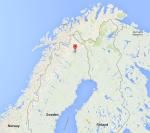
SSETI Express XO-53 streaks across the dark Swedish sky on October 27, 2015.
Two images combined, and zoomed. As you can see, they caught a flare.
The gap in the middle is when the mirror of the camera was moving in between shots.
The two stars marked are the upper two of The Plough.
The XO-53 (SSETI Express) satellite was launched October 27, 2005 at 06:52 UT on board a Kosmos 3M rocket launched from the Plesetsk Cosmodrome in central Russia.
SSETI Express was developed by the Education Office of the European Space Agency (ESA) as part of the “Student Space Exploration and Technology Initiative”. The satellite measures 60x60x70 cm with a mass of about 50 kg. It was built by university students from a number of teams from all across Europe and assembled at the ESA ESTEC facility in the Netherlands.
AMSAT-UK provided a 3 watt S band transmitter to the project – on the basis that it could be linked to the UHF receiver for operation as a single channel FM voice transponder when all the experiments have been completed. The unit also incorporates its own switch mode power supply and a 38k4 TNC to allow the rapid downlinking of data – especially necessary for the camera experiment.
Shortly after launch SSETI deployed three CubeSats, XI-V, UWE-1 and Ncube-2, developed by university students. After deploying the CubeSats, XO-53’s batteries stopped charging and the spacecraft went silent.
On the 10th Anniversary of the SSETI Express Launch a crack squad of geeks, Neil Melville-Kenney PA9N, Graham Shirville G3VZV, Karl Kaas OZ2KK, Sascha Tietz KJ6LIL and Lars Mehnen OE3HWM, headed to the ESRANGE facility in Northern Sweden to attempt to SEE the spacecraft for the first time in a decade.
They successfully captured images of the satellite as it streaked across the dark Swedish sky.
Read the AMSAT-UK SSETI Express Handbook
Read the Story of the birth of the On Board Computer for SSETI Express by Karl Kaas
AMSAT-UK has been given exclusive access to the report on the hunt for SSETI Express. Read the SSETI Express Phase E – 400-800 THz Downlink Report
Further pictures are available on the Facebook page of Neil Melville-Kenney PA9N

Explanation of SSETI Express observed flare in terms of the two images captured Oct. 27, 2015
Note team couldn’t use mirror lock-up in combination with the specific remote, hence wobble
![]()

